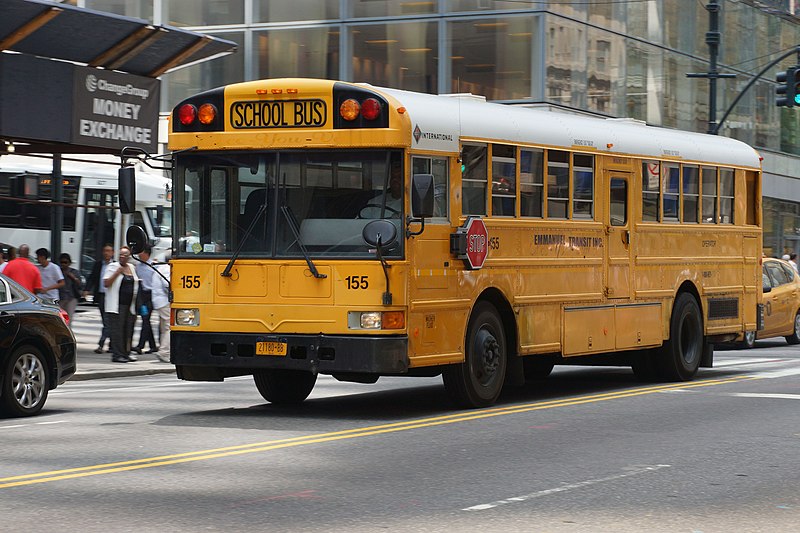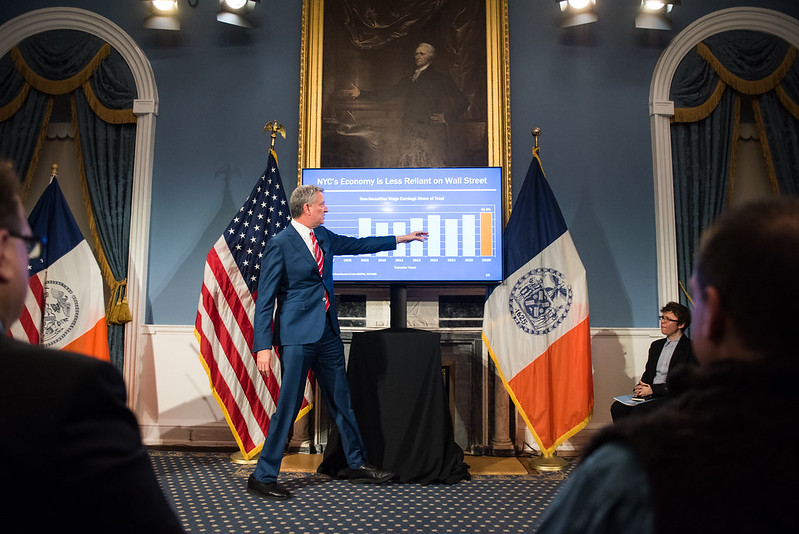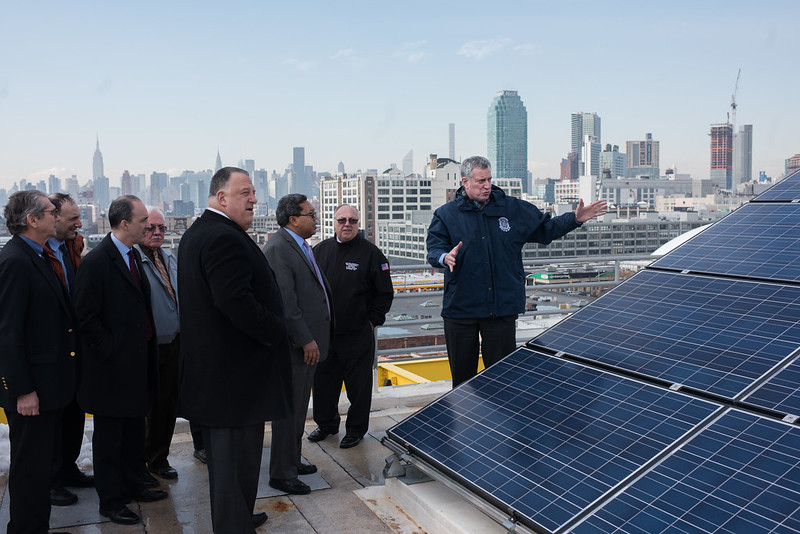Should New York City Cut School Bus Service?

A school bus in the city (Wikimedia Commons)
Challenged by reduced bus capacity due to social distancing and strained budgets, school districts face difficult decisions about school busing this fall. How can districts allocate scarce busing resources to best support students? Some districts, like Dayton, Ohio, are considering eliminating bus service for charter schools. Others would go farther, proposing to limit bus service to students for whom it is legally mandated -- those with Individual Education Programs (IEPs) and those living in temporary housing -- leaving other students to walk, use public transit or private transportation.
Our work suggests that the impact of such cuts would fall disproportionately on low-income, Black, and Hispanic students, and reduce educational opportunity for students living in disadvantaged neighborhoods. Although cutting school bus service may seem like an “easy” way to save money, educators and policymakers should wield the budget knife carefully.
Buses are Important
While many downplay the importance of school buses in cities with high density and robust public transportation systems, our work in New York City highlights the significant role school buses play in urban districts. School buses transport students with disabilities to appropriate schools, help children living in temporary housing avoid the disruption of transitory school changes, transport students who live far from their neighborhood school, and enable low-income children in disadvantaged neighborhoods to access higher quality schools (including charters).
All Kinds of Students Take the Bus
According to 2017 ridership data, more than 115,000 K-8 public school children take a school bus in New York City. Nearly half have bus service mandated as part of their IEP or under the federal McKinney-Vento Act, which requires districts to provide homeless students with transportation to their origin school. Eliminating bus service for these students is neither legal nor desirable.
The remaining 60,000-plus students who take the bus are eligible for service because they live outside their school’s “walk zone” – a half mile for students in grades K-2, a mile for students in grades 3-6, and 1.5 miles for grades 7-8. These students are also offered the option of a Metrocard, which allows free use of public transit, but choose to ride the school bus instead. They include a racially diverse mix of students from all five boroughs, and a majority are from low-income households.
Roughly 60 percent of school bus-riding students attend a charter or magnet school or another neighborhood’s zoned school that offers a preferred program. Among these “choice school” students, those who ride the bus are significantly more likely to attend a ‘better’ school (with higher performing students) outside of their neighborhood than students attending choice schools close to home. These students are disproportionately Black and Hispanic, suggesting the school bus serves to reduce racial/ethnic disparities in access to good schools.
Where to Find Savings?
Let More Kids Walk
New York City can expand current walk zones to match those used by other large urban districts. In Baltimore, Boston, and Philadelphia, for example, even the youngest students must live more than a mile from school to receive bus service and older students more than 1.5 miles. If New York City followed suit, expanding the walk zones to one mile for K-2 students and 1.5 miles for grades 3-6, the number of school bus riders would drop by roughly 35 percent.
Let Older Students Rely on Public Transit
Most students living outside the middle school walk zone are only offered Metrocards and not school bus service, with options often determined by the school principal. Accordingly, roughly four out of five middle school students who live outside the walk zone already use public transit. Eliminating the bus for middle school students would decrease bus ridership by approximately 10,000 students.
Eliminate Busing to Charter Schools
Students attending charter schools currently receive the same bus service as students attending traditional public schools and are subject to the same eligibility rules. Expanding walk zones would reduce the number of charter school students taking the bus, but a sizable number would still live far enough away to be eligible for bus service. Eliminating bus service to charter schools entirely – as Dayton is considering – would reduce bus ridership by about 20 percent, roughly 90 percent of which would be Black or Hispanic students.
Assessing the Costs and Benefits
While the direct financial consequences of reducing school bus service may be clear, there will also be a set of unintended benefits and, inevitably, costs. As for benefits, reducing bus service may encourage more students to walk or use “active transportation,” such as biking or skateboarding, with positive effects on physical activity, time spent outdoors, and reductions in obesity.
As for costs, reducing bus service may increase reliance on public transit, which could expose students (or other riders) to an increased risk of COVID-19. In another vein, whether students walk or use transit, the lack of supervision on the commute may pose additional safety risks. Finally, families faced with difficult commutes to a choice school may be compelled to move their child to a school close to home, causing educational disruption and, potentially, a less appropriate educational setting for their child. These losses are likely to be particularly large in low-income Black and Hispanic communities already hard hit by COVID-19.
Weighing the benefits and costs is difficult because of so much uncertainty around transmission and the modality of instruction in the fall. Our take is that, on balance, eliminating all service to charters would entail substantially higher educational costs than expanding the walk zone. Reducing the availability of school buses to middle schools is also appealing, particularly because larger walk zones would significantly reduce the number of students who would even be eligible. Of course, exceptions will have to be made to accommodate unusual individual circumstances, such as hazardous walking routes. For many students, however, getting off the bus would be neither onerous nor detrimental to their education. It may even do them some good.
***
by Amy Ellen Schwartz, Sarah Cordes, Jeffrey Zabel & Christopher Rick.
Schwartz is the Daniel Patrick Moynihan Chair in Public Affairs at Syracuse University, Professor of Economics and Public Administration and Director of Transportation Research at the IES funded REACH Center.
Cordes is an Assistant Professor of Policy, Organizational, and Leadership Studies at Temple University and a Research Partner with the IES funded REACH center.
Zabel is a Professor of Economics and Co-Director of the MS Program in Data Analytics at Tufts University. He is the Co-Editor of the Journal of Housing Economics.
Rick is a doctoral student in public administration at the Maxwell School, Syracuse University.
***
Have an op-ed idea or submission for Gotham Gazette? Email This email address is being protected from spambots. You need JavaScript enabled to view it.
Mayor Must Bridge Budget Gap Without Borrowing or Mass Layoffs

(photo: Edwin J. Torres/ Mayoral Photo Office)
Despite a full-court press from cities and states across the country, Congress left for August recess without passing joint legislation to provide them with federal financial assistance. This aid is desperately needed by localities, both red and blue, that have suffered dramatic revenue losses due to the shutdown of much of their economies during the pandemic. There is still hope that some amount of aid will eventually be forthcoming, but not in time or in sufficient amount to address the dire needs of New York City and State.
While the current fiscal year budget for the city is technically balanced, it includes some big risks, such as large police overtime reductions that are often attempted but never achieved and a $1 billion target for labor savings with no details or signs that any real discussion is taking place. The projected deficit for next fiscal year is $4.2 billion. So the likelihood is that the combined two-year deficit is close to $6 billion, maybe more.
But Mayor de Blasio has delayed taking action to address the gap until October, hoping that federal funding would come through in the meantime. As that prospect looks more and more unlikely, he has taken to warning that 22,000 layoffs will be necessary unless the city is given permission by the state to borrow money to cover the shortfall; to make the threat more real and compelling to legislators, notices of the number and savings value of possible layoffs by agency are scheduled to be released on August 31 and there have been leaked reports of dire consequences such as layoffs of hundreds of EMTs and thousands of teachers.
The mayor bristles at comparisons of the current situation to the 1970s when the city relied so heavily on financing its expenditures that it got to the point when no one would loan it any more money. Yes, the reason for the revenue shortfall now is different. Then, it was a problem of spending persistently exceeding resources; now it is a dramatic and sudden loss of revenue caused by an unanticipated health calamity. But the result is the same: the city is not generating enough tax revenue (or state and federal aid) to pay for all its costs. And while we can and should be bullish about the city’s resiliency, there is reason to believe that its economic recovery will take several years at best; and the size and nature of the economy may be quite different than what it was before everything changed in March.
Borrowing for the next two years will not solve the problem, but only exacerbate it, because if there is insufficient revenue to cover expenses, more borrowing will be required and so on. Taxpayers of tomorrow will be paying hundreds of millions of dollars of debt service for bad decisions of today. It took until 2008 for the debt incurred to save New York City from bankruptcy in the ‘70s to be finally retired. The mayor has said that to keep debt service payments manageable he would cut capital spending (the only valid purpose for financing), a decision that could curtail high-priority infrastructure investments that are important to the city’s revitalization.
Unlike in the ‘70s, the state is not in a position to backstop the city by stepping in to take over its debt as it did then by creating the Municipal Assistance Corporation. Indeed, New York State is in even worse financial straits than the city, with skyrocketing Medicaid and unemployment insurance costs, not to mention the MTA on the brink of disaster.
What is needed are thoughtful, strategic spending reductions, not the across-the-board layoffs the mayor is threatening. The Citizens Budget Commission and other experts have come up with a number of valid suggestions including reductions in the cost of fringe benefits and productivity improvements. Public employee unions can be especially helpful in agreeing to compensation and work-rule and staffing changes so that all savings do not result in reductions to services to residents. No ideas should be shelved out of the belief that union opposition would be insurmountable; now is the time for doing what conventional wisdom would say is impossible. A serious, good faith effort by the de Blasio administration, the City Council, and public employee unions, working together to use a scalpel, not a hatchet, can significantly reduce costs and minimize the amount, if any, of borrowing required.
Let us be clear: our opposition to borrowing to pay operating expenses is not driven by a small government ideology. Rather it arises from a commitment to strong, secure, well-managed government and a desire to avoid even worse austerity measures that will come if we don’t make politically difficult but necessary decisions now.
Both the City and State Comptrollers, as members of the New York State Financial Control Board and as fiscal watchdogs, have an obligation to state clearly and unequivocally that borrowing our way out of the current crisis with no conditions or requirements for spending discipline (i.e. a reinstatement of the oversight and control powers of the Control Board) is not viable and should not be permitted. If they and legislative leaders Speaker Carl Heastie and Majority Leader Andrea Stewart-Cousins cave to pressure from public employee unions and others who don’t want to take responsibility for managing through the crisis, they will be complicit in kicking the can down the road and will bear the responsibility for the even more draconian actions that will need to be taken under the next mayor.
***
Carol Kellermann was president of Citizens Budget Commission from 2008 through 2018. Norman Steisel was a First Deputy Mayor of New York City, Sanitation Commissioner, and First Deputy Budget Director, all between 1974 and 1994.
***
Have an op-ed idea or submission for Gotham Gazette? Email This email address is being protected from spambots. You need JavaScript enabled to view it.
The Climate and Economic Plan for New York City’s Future That We Need Now

(photo: Michael Appleton/Mayoral Photography Office)
In March, I found myself with a 104-degree fever on my 18th birthday. My dad wasn’t faring any better, requiring a hospital visit and remaining sick for 12 days. After testing positive for COVID-19, we knew to stay isolated for 14 days once symptoms subsided, which was when my dad decided to get back to work. However, the economy decided against it.
He and his IBEW Local 3 brothers and sisters, along with thousands of other building and construction trade union members, saw job sites grind to a halt. From bodegas to banks, much of the business capital of the world quickly shuttered.
As a young person, I’m forced to reckon with a number of urgent crises: the destruction wrought by the COVID-19 outbreak, an economic recession, systemic racism, and climate change. We need a solution for New York City that addresses all four urgently.
As a New Yorker, 2020 hasn’t been easy – every day seems to bring more bad news. From March to August, we watched as tens of thousands of our neighbors died at the hands of COVID-19, the economy plummeted, and the city erupted in protests against racism. We’re still in the thick of crises. Nationwide COVID cases are on the rise, local unemployment is at more than 20%, and we’re inching towards the ‘point of no return’ for global warming. And yet, somehow, New Yorkers are expected to pay the rent.
While New Yorkers are suffering, it’s important to note where the current political climate intersects with the economy. The demands of the Black Lives Matter movement don’t end with police reform, but total economic and social parity for Black Americans. The statistics are startling: BIPOC unemployment is 2-5% higher than white unemployment while Black workers make under 60 cents on the white workers’ dollar. Now emerging from the pandemic, our most vulnerable neighbors cannot afford to return to ‘normal.’
New York City needs a local stimulus to get us through the pandemic while positioning the economy to be more robust and equitable, helping workers like my dad.
For years, the Climate Works for All coalition, a collection of local labor, environmental, and social justice groups, has been fighting for a ‘just transition’ to a sustainable climate and a fair economy. Since the COVID-19 crisis began, the coalition has developed the Climate and Community Stimulus Platform, a climate jobs recovery plan that outlines citywide infrastructure projects, putting 100,000 New Yorkers back to work and moving us towards our climate goals.
The platform continues green work already in progress throughout the city while also building new industries and making older sectors energy efficient. To expand upon Local Law 97, which requires a reduction in building carbon usage across the city up to 80% by 2050, the plan proposes funding for low-income and NYCHA housing retrofits. Small, midsize multi-family, and larger public housing units will all require some level of city funding to effectively meet Local Law 97 guidelines, and there’s no time like the present to begin this work. Using federal, state, NYSERDA, and local funding streams, we can raise the capital needed to hire thousands of workers as our city hits peak unemployment, building green infrastructure that will pay dividends for all New Yorkers for years to come. With local hiring promises and project labor agreements (PLAs), workers will be afforded safe and dignified jobs in their communities.
The Climate and Community Stimulus Platform also promotes bringing old sectors, such as transportation and manufacturing, into the 21st century green economy. Increased funding to electronic vehicle charging stations and MTA improvements would allow our city’s transportation infrastructure to meet the demands of its population. Funding for port development and electrification will help reinvigorate New York City’s manufacturing industry and promote local blue-collar job creation. It will bring the New York harbor to the forefront of the offshore wind industry, creating hundreds of new manufacturing and staging jobs.
Workforce development programs would support these projects by training workers for a green economy and the new jobs that come with it. Investments would also prioritize underserved minority communities, who have been disproportionately impacted by the COVID-19 crisis and resulting economic recession.
The proposal has had buy-in from all aspects of the policy field, from unions like IBEW Local 3 and IUPAT District Council 9 to environmental organizations such as the Sierra Club and New York Renews, and community groups like Make the Road New York and UPROSE. We’ve also included the voices of future generations of New Yorkers by working with TREEage, a youth climate justice organization that has been involved with the youth climate movement and Climate Strike NYC.
It is time for immediate action before these overlapping crises worsen, and the New York City Climate and Community Stimulus Platform is the tool we need to protect New Yorkers before a second wave.
***
Scott Siegel is co-policy director at TREEage, a youth climate organization based in New York City. On Twitter @scottsiegelny.
***
Have an op-ed idea or submission for Gotham Gazette? Email This email address is being protected from spambots. You need JavaScript enabled to view it.




